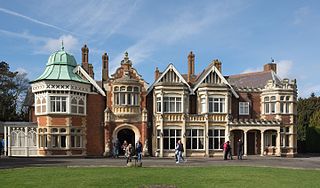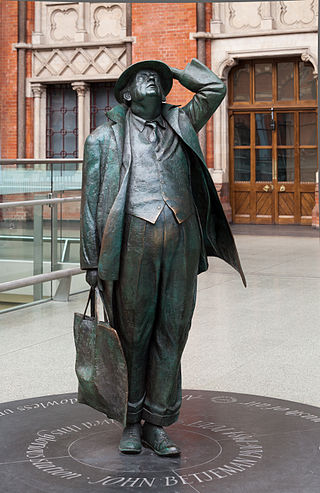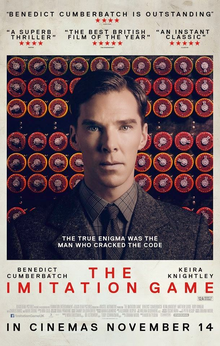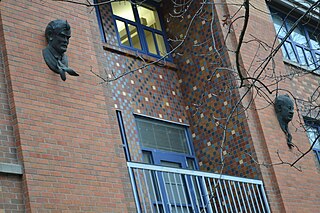
Alan Mathison Turing was an English mathematician, computer scientist, logician, cryptanalyst, philosopher, and theoretical biologist. Turing was highly influential in the development of theoretical computer science, providing a formalisation of the concepts of algorithm and computation with the Turing machine, which can be considered a model of a general-purpose computer. He is widely considered to be the father of theoretical computer science and artificial intelligence.

Bletchley Park is an English country house and estate in Bletchley, Milton Keynes (Buckinghamshire) that became the principal centre of Allied code-breaking during the Second World War. The mansion was constructed during the years following 1883 for the financier and politician Sir Herbert Leon in the Victorian Gothic, Tudor, and Dutch Baroque styles, on the site of older buildings of the same name.

Grenville Davey was a British sculptor and winner of the 1992 Turner Prize.

Ian Rank-Broadley FRBS is a British sculptor who has produced many acclaimed works, among which are several designs for British coinage and the memorial statue of Princess Diana at Kensington Palace in London unveiled on her 60th birthday in 2021.

Sidney E. Frank was an American businessman and philanthropist. He became a billionaire through his promotion of Grey Goose vodka and Jägermeister.

The Alan Turing Memorial, situated in Sackville Gardens in Manchester, England, is a sculpture in memory of Alan Turing, a pioneer of modern computing.

Donald Michie was a British researcher in artificial intelligence. During World War II, Michie worked for the Government Code and Cypher School at Bletchley Park, contributing to the effort to solve "Tunny", a German teleprinter cipher.
The year 2007 in art involved some significant events and new works.
The Alan Turing Year, 2012, marked the celebration of the life and scientific influence of Alan Turing during the centenary of his birth on 23 June 1912. Turing had an important influence on computing, computer science, artificial intelligence, developmental biology, and the mathematical theory of computability and made important contributions to code-breaking during the Second World War. The Alan Turing Centenary Advisory committee (TCAC) was originally set up by Professor Barry Cooper

Mitchell Fields was a Romanian-born American sculptor, known for his life-size sculptures, as well as for his portraits. Fields's works belong to the schools of Realism and Social Realism.

The fourth plinth is the northwest plinth in Trafalgar Square in central London. It was originally intended to hold an equestrian statue of William IV, but remained bare due to insufficient funds. For over 150 years the fate of the plinth was debated; in 1998, the Royal Society for the encouragement of Arts, Manufactures and Commerce (RSA) commissioned three contemporary sculptures to be displayed temporarily on the plinth. Shortly afterwards, Chris Smith, Secretary of State for Culture, Media and Sport, commissioned Sir John Mortimer to seek opinions from public art commissioners, critics and members of the public as to the future of the plinth.
Angela Conner FRSS is an English sculptor who works in London. Conner has exhibited internationally and has large scale sculptures in public and private collections around the world.

Martin Jennings, FRBS is a British sculptor who works in the figurative tradition, in bronze and stone. His statue of John Betjeman at St Pancras railway station was unveiled in 2007 and the statue of Philip Larkin at Hull Paragon Interchange station was presented in 2010. His statue of Mary Seacole (2016), one of his largest works, stands in the grounds of St Thomas' Hospital in central London, looking over the Thames towards the Houses of Parliament.

The Imitation Game is a 2014 American period biographical thriller film directed by Morten Tyldum and written by Graham Moore, based on the 1983 biography Alan Turing: The Enigma by Andrew Hodges.

Alan Turing, sometimes spelled Allen Turing and also known as Allen Turing Gargoyle, is an outdoor 1988 hammered copper sheet sculpture of Alan Turing by Wayne Chabre, installed on the exterior of Deschutes Hall on the University of Oregon campus in Eugene, Oregon, in the United States. The portrait face in high relief measures approximately 3 feet (0.91 m) x 1.5 feet (0.46 m) x 1.5 feet (0.46 m) and cost $2,500. Its condition was undetermined when the Smithsonian Institution surveyed the work as part of its "Save Outdoor Sculpture!" program in March 1993.
Albert George Power was an Irish sculptor in the academic realist style. He is particularly known for his iconic statue of the Irish writer Pádraic Ó Conaire.
About 8,000 women worked in Bletchley Park, the central site for British cryptanalysts during World War II. Women constituted roughly 75% of the workforce there. While women were overwhelmingly under-represented in high-level work, such as cryptanalysis, they were employed in large numbers in other important work, such as operating cryptographic machinery and communications machinery; translating of Axis documents; traffic analysis; clerical duties, and many more besides. Women made up the majority of Bletchley Park’s workforce, most enlisted in the Women’s Royal Naval Service, WRNS, nicknamed the Wrens.

A statue of Alan Turing, created in slate by Stephen Kettle in 2007, is located at Bletchley Park in England as part of an exhibition that honours Turing (1912–1954). It was commissioned by the American businessman and philanthropist Sidney Frank (1919–2006).

Alan Turing was an English mathematician, computer scientist, logician, cryptanalyst, philosopher, and theoretical biologist. He left an extensive legacy in mathematics, science, society and popular culture.

The statue of Mary Seacole stands in the grounds of St Thomas' Hospital, Lambeth, London. Sculpted by Martin Jennings, the statue was executed in 2016. It honours Mary Seacole, a British-Jamaican who established a "British Hotel" during the Crimean War and who was posthumously voted first in a poll of "100 Great Black Britons".
















